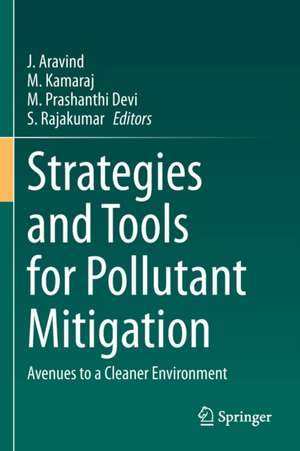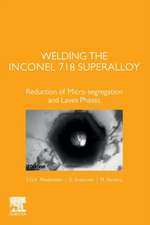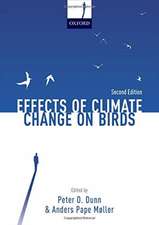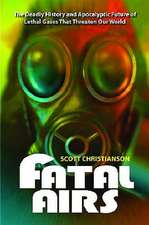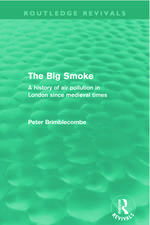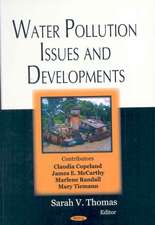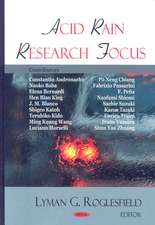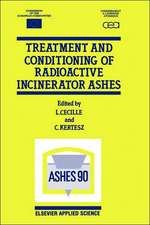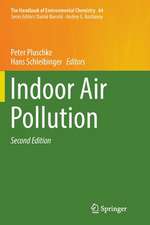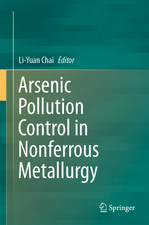Strategies and Tools for Pollutant Mitigation: Avenues to a Cleaner Environment
Editat de J. Aravind, M. Kamaraj, M. Prashanthi Devi, S. Rajakumaren Limba Engleză Paperback – 29 mar 2022
| Toate formatele și edițiile | Preț | Express |
|---|---|---|
| Paperback (1) | 897.81 lei 43-57 zile | |
| Springer International Publishing – 29 mar 2022 | 897.81 lei 43-57 zile | |
| Hardback (1) | 903.93 lei 43-57 zile | |
| Springer International Publishing – 25 mar 2021 | 903.93 lei 43-57 zile |
Preț: 897.81 lei
Preț vechi: 1094.89 lei
-18% Nou
Puncte Express: 1347
Preț estimativ în valută:
171.79€ • 179.85$ • 142.15£
171.79€ • 179.85$ • 142.15£
Carte tipărită la comandă
Livrare economică 07-21 aprilie
Preluare comenzi: 021 569.72.76
Specificații
ISBN-13: 9783030635770
ISBN-10: 3030635775
Pagini: 450
Ilustrații: VII, 450 p. 92 illus.
Dimensiuni: 155 x 235 mm
Greutate: 0.64 kg
Ediția:1st ed. 2021
Editura: Springer International Publishing
Colecția Springer
Locul publicării:Cham, Switzerland
ISBN-10: 3030635775
Pagini: 450
Ilustrații: VII, 450 p. 92 illus.
Dimensiuni: 155 x 235 mm
Greutate: 0.64 kg
Ediția:1st ed. 2021
Editura: Springer International Publishing
Colecția Springer
Locul publicării:Cham, Switzerland
Cuprins
Part I- Reviews on energy and environment.- Chapter 1. A review on production, properties and applications microbial surfactants as a promising biomolecule for environmental applications (Kidist Mulugeta, M. Kamaraj, Mesfin Tafesse & J. Aravind).- Chapter 2. Hairy Root Applications in Phytoremediation – An updated Review (Anil Kumar Moola, Balasubramanian P, Lakkakula Satish, Sasanala Shamili, Manikandan Ramesh, T. Senthil Kumar & B. D. Ranjitha Kumari).- Chapter 3. Pretreatment of wheat straw using ionic liquids for bioethanol production – A review (Ibsa Neme & Chandra Masi).- Chapter 4. Harnessing the sustainable bioresource, cellulose at the nanoscale for multifarious environmental applications (Ebrahim M. Abda & Rocktotpal Konwarh).- Chapter 5. Allelochemicals as natural herbicides for sustainable agriculture to promote a cleaner environment- A review (Hemalatha Palanivel, Gebiyaw Tilaye, Sathish Kumar Belliathan, Solomon Benor, Solomon Abera & Kamaraj M).- Chapter 6. Strategiesand limitations of water treatment methods for point-of-use application (N. R. Srinivasan, M. Kamaraj & S. Venkatesa Prabhu).- Part II - Cleaner technologies on mitigation of organic and inorganic pollutants.- Chapter 7. Recent trends in application of Bacterial polymers to mitigate organic and inorganic pollutants (P Muthukumaran, J Aravind, M Kamaraj & KK Ramachandran).- Chapter 8. Bioremediation: Efficient technology to combat Pesticide pollutants in Environment (Raman Kumar Ravi & R.Y. Hiranmai).- Chapter 9. Removal of dyes from industrial effluents using bioremediation technique (Narayana Saibaba K.V.).- Chapter 10. A harmless approach on textile effluent detoxification: bioremediation and its recent strategies (R. Kavitha, S. Venkatesa Prabhu & Melkamu Kifetew. M).- Chapter 11. Modern Bioremediation Approaches for Clean and Green Environment (AnkitaMurmu, S. Murugan).- Chapter 12. Arsenic-transforming bacteria – A potential weapon for Arsenic contaminated soil (Radhesh Krishnan Subramanian & Prabhakaran Narayanasamy).- Chapter 13. Phycoremediation of heavy metals, factors involved and mechanisms related to functional groups in the algae cell surface- A review (Abate Ayele, Arumuganainar Suresh & Solomon Benor).- Chapter 14. Heavy Metal Extraction from E-Waste through Bioleaching: A Promising Ecofriendly Approach (S. Venkatesa Prabhu, N.R. Srinivasan & Sintayehu Mekuria. H.).- Chapter 15. Potential of Free Floating Macrophytes for Bioremediation of Heavy Metals – A conceptual Review (Punita Parikh & Krupa Unadkat).- Chapter 16. Bioremediation of heavy metals using Salvinia molesta – a freshwater aquatic weed for pollutant remediation approach (Nithya T.G, Snegapriya P & Kamaraj M).- Chapter 17. Mycoremediation: Fungal-based technology for biosorption of heavy metals – A Review (Abate Ayele, Setegn Haile, Digafe Alemu, Tamiru Tesfay & Kamaraj Murugesan).- Part III - Impact and risk assessments.- Chapter 18. Geospatial modelling of air pollution and its impact on the health of urban residents using spatial statistical models - A review (Janani Selvaraj, Harathi Dayalan & Prashanthi Devi M).- Chapter 19. Health impacts of contaminated water in India: Coping Strategies for Sustainable Development (J.V. Arun & A. Premkumar).- Chapter 20. The potential of biotechnology on soil quality by minimizing agrochemical impact to ensure sustainable agriculture - A review (Solomon Abera)
Notă biografică
Dr. J. Aravind is a Professor in the Civil Engineering Department at Dhirajlal Gandhi College of Technology, India. He is an Associate Editor in International Journal of Environmental Science and Technology (Springer Nature), has published 50 plus articles with a cumulative impact factor of 62.96, google h-index 15 (Scopus h-index 10) with total citations of 690 (Scopus citation of 395), also co-editor of Bio-remediation and Sustainable Technologies for Cleaner Environment- Springer Nature, one among top 25% downloads for three consecutive years 2017-19.
Dr. M. Kamaraj is an Associate Professor in the Department of Biotechnology at Addis Ababa Science and Technology University, Ethiopia. He has seven years of research and teaching experience (India and Ethiopia). He has published 36 research articles (with a cumulative impact factor of 38.25) and 2 book chapters and have a Google h index -11 with total citations of 565.
Dr. M. Prashanthi is an Assistant Professor in the Department of Environmental Management at Bharathidasan University, India, with an experience of fifteen years of research in Environmental Health and Waste Management. Her research work concentrates on mapping of environmental exposures to health issues using RS and GIS techniques. She has published 44 research papers and authored two books. She has edited two books with Springer on Integrated Waste Management in India and Bioremediation and sustainable technologies for cleaner environment.
Dr. S. Rajakumar is an Assistant Professor in the Department of Marine Biotechnology at Bharathidasan University, India. He has a research experience of fourteen years specialising in Environmental Microbiology and Bioremediation, his important research works include Biomethanation and bioconversion of marine weeds, Detoxification of Benzene, Toluene, Ethyl benzene and Xylene (BTEX) and its derivatives and Biodegradation of Arsenic and Lead from Groundwaterand soil. Having published 50 research papers, he has edited two books with Springer publications.
Dr. M. Kamaraj is an Associate Professor in the Department of Biotechnology at Addis Ababa Science and Technology University, Ethiopia. He has seven years of research and teaching experience (India and Ethiopia). He has published 36 research articles (with a cumulative impact factor of 38.25) and 2 book chapters and have a Google h index -11 with total citations of 565.
Dr. M. Prashanthi is an Assistant Professor in the Department of Environmental Management at Bharathidasan University, India, with an experience of fifteen years of research in Environmental Health and Waste Management. Her research work concentrates on mapping of environmental exposures to health issues using RS and GIS techniques. She has published 44 research papers and authored two books. She has edited two books with Springer on Integrated Waste Management in India and Bioremediation and sustainable technologies for cleaner environment.
Dr. S. Rajakumar is an Assistant Professor in the Department of Marine Biotechnology at Bharathidasan University, India. He has a research experience of fourteen years specialising in Environmental Microbiology and Bioremediation, his important research works include Biomethanation and bioconversion of marine weeds, Detoxification of Benzene, Toluene, Ethyl benzene and Xylene (BTEX) and its derivatives and Biodegradation of Arsenic and Lead from Groundwaterand soil. Having published 50 research papers, he has edited two books with Springer publications.
Textul de pe ultima copertă
This volume explores recent research trends and achievements in environmental pollution remediation (e.g. water, air, soil), and compiles critical and constructive papers and reviews with a focus on advances in bioremediation and green technology solutions for waste minimization, waste management and pollution control. The book is timely, as the need for researchers and engineers to develop sustainable and green eco-friendly remediation technologies is increasing with a growing global population, stressed agricultural systems, and an environment impacted by climate change. A key focus of the book is on the efficient use of agricultural waste residues as viable substrates for creating materials for environmental clean-up, and the possible conversion of these pollutants to sustainable bioresources. The volume will be of interest to sustainability researchers, environmental engineers, industry managers and agricultural scientists.
Caracteristici
Discusses recent achievements in environmental pollution remediation Presents green technology solutions for waste management and pollution control Reviews methods to convert pollutants into useful bioresources
